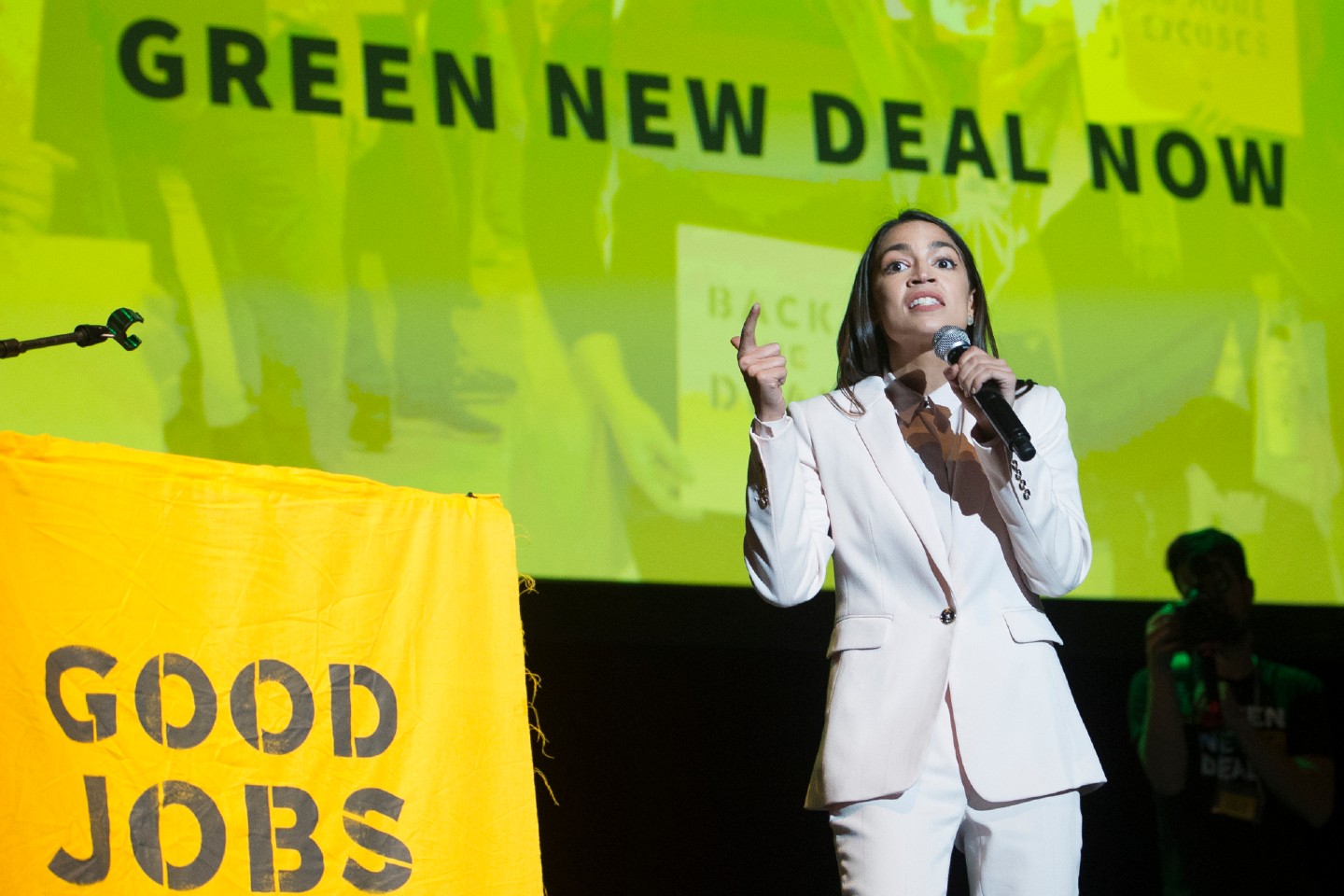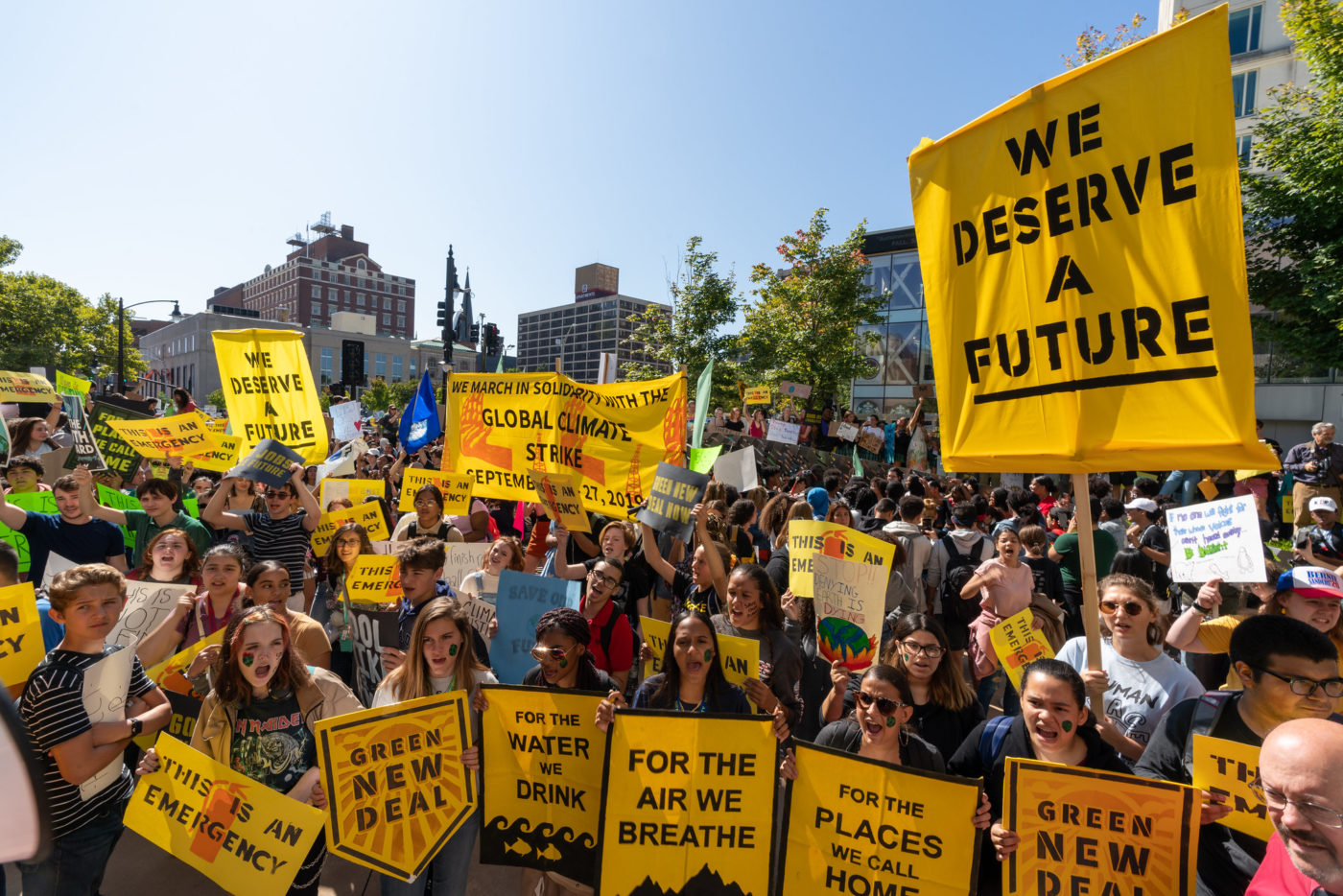
For the past two years, people who Google the term “cost of Green New Deal” have seen at the top of their results a price tag of $93 trillion.
This figure comes from something called the American Action Forum (AAF), which is described by sites like Wikipedia and FactCheck as “center-right” or “conservative.” In Google search results, the “featured snippet” up top about the Green New Deal references Wikipedia and says AAF estimates the cost at $600,000 per household. This is probably when many internet searchers close the tab. Other searchers see a sponsored ad from the R Street Institute, titled “Big Problems in Green New Deal,” that warns of potential costs to consumers.
Calling AAF conservative doesn’t capture the backing of the think tank by the fossil fuel industry through donations to its sibling group, the dark money behemoth American Action Network (AAN). Also, the “conservative” tag fails to mention the involvement of Republican policy staffers who have gone through the revolving door in calculating the $93 trillion sum. As an estimate of the gross federal spending required for an effective climate plan, it could be inflated by a factor of 10. But the $93 trillion number was not meant to be accurate as it is presented, on its own—it was thrown online to squat atop search results and be mentioned in the media as a supposedly unfathomable amount. For example, in the presidential debates, Trump tossed out a supposed Green New Deal cost of $100 trillion.
The Green New Deal (GND) frequently refers to a nonbinding resolution introduced in the previous Congress by Rep. Alexandria Ocasio-Cortez (D-N.Y.) and Sen. Ed Markey (D-Mass.). The GND calls for a ten-year national mobilization, including investing in renewable energy infrastructure and building a more just economy that repairs environmental damages historically concentrated in frontline communities. One summary of the text of the GND as five main goals is available from the think tank New Consensus, or in explainers like one last year by The New York Times. Many of its policy components have been well studied by environmental experts and economists, but its exact proposals are not finalized, which is by design. The big-picture process of ramping up the GND would combine actions by the federal executive branch in concert with sweeping legislation passed by Congress that would give grants to state governments with the goal of creating 10 million new jobs over the first 10 years. Federal and state governments would implement policy and enforce regulations to reach decarbonization goals such as net-zero building energy standards by 2030, 100% clean and renewable electricity by 2035, and zero net emissions from energy by 2050.
The GND resolution ended the last Congress with 101 House cosponsors, over 43% of Democratic reps, and 14 Senate cosponsors. In the current Congress, where the next pandemic response is on deck, 200 groups including the Green New Deal network have endorsed a Thrive agenda—also introduced on Feb. 8 as a congressional resolution—for an economic recovery plan that tackles the climate crisis and addresses racial injustice, incorporating policy approaches from the GND.

Even before the GND’s legislative details have been introduced, in beginning to estimate the costs involved with fulfilling parts of the resolution, researchers have to factor in not only the gross and net costs, but the savings and possibilities for more sustainable growth, as well as the severe costs of the status quo. For example, a 2015 report by the research arm of Citigroup found that the costs of inaction on climate by 2040 would be $192 trillion, while an “action” scenario, shifting to renewable energy, would cost less, at $190.2 trillion. Which is to say nothing of saving lives, preserving a habitable environment, and mitigating the worst effects of catastrophic climate degradation, as outlined in the landmark 2018 report by the UN Intergovernmental Panel on Climate Change.
In mid-2019, Ocasio-Cortez estimated a minimum of $10 trillion was needed for effective investment in meeting the climate challenge. A few months before, Edward Barbier, a professor of economics at Colorado State University, estimated that based on South Korea’s spending on decarbonization, some $970 billion over five years was the target, or nearly $2 trillion over a decade. For context, the U.S. GDP in 2019 was $21.5 trillion and its total federal budget for last year was $4.8 trillion, and GDP had seen 2% growth for several years before while budgets rose by over 7% annually.
The AAF published a summary of the GND in February 2019, but the $93 trillion figure did not appear until a March analysis, where it was described as a “high end” estimate. Even that month, the group’s president, Republican economist Douglas Holtz-Eakin, didn’t totally stand behind it. Another top search result for “cost of GND,” from FactCheck.org of The Annenberg Public Policy Center, notes that the $93 trillion top-line number doesn’t include important caveats, quoting Holtz-Eakin as saying, “The figure’s not wrong, but it’s incomplete.” Yet millions of internet searchers are seeing the figure displayed with much less context, not realizing it is AAF’s potentially 10x-inflated 10-year estimate.
The AAF research institute has received millions of dollars in funding from its sister organization the American Action Network (AAN), a secretive nonprofit run by Republican political operatives that is part of a web of conservative dark money groups. Last election cycle, AAN was the top contributor to the Congressional Leadership Fund, the Republican-aligned super PAC that successfully defended House GOP seats, giving it at least $26.4 million.
AAN does not disclose its funders, but tax records show that it has received large donations from the fossil fuel industry, such as $250,000 from the American Petroleum Institute (API) in 2012, and $35,000 from the American Natural Gas Alliance in 2010. The Business Roundtable, a prominent lobby group for big business whose members include the CEOs of oil giants BP, Chevron, and ExxonMobil, held a panel on deficit reduction with Holtz-Eakin, and AAF has shared the Business Roundtable’s proposals on federal debt. AAF received $100,000 from API in 2019.
One of the AAF report’s co-authors, Philip Rossetti, was formerly the group’s director of energy policy. In August 2019, Rossetti joined the House Select Committee on the Climate Crisis’ Republican minority staff as a fellow working on energy and climate policy. In October 2020, he revolved out to the libertarian think tank R Street Institute as a senior fellow on energy and the environment. The R Street Institute is a member of the right-wing State Policy Network, which has received tens of millions of dollars in funding in years past from Koch network sources such as Donors Trust and Donors Capital Fund, as well as donations from the American Fuel and Petrochemical Manufacturers association, the Edison Electric Institute association, and conservative family foundations. The R Street Institute is currently buying anti-GND Google search ads for several GND-related search terms.
For a typical internet user seeking to understand what is known about the financial outlays of the Green New Deal, here is one way of thinking about the proposal that puts trillions in spending over ten years in more context than AAF’s top line figure. Allocating a trillion dollars annually for GND-type programs is an investment the size of about one-fifth of the federal budget, which in turn is just over one-fifth of U.S. GDP, that not only generates more sustainable economic activity, but also preserves health, the environment, and human well-being compared with the harms of continued fossil fuel extraction.
For more digging into the fossil fuel industry’s information laundering, check out Sludge’s newsletter.
